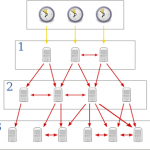Stratum Levels & NTP Explained | Welcome to the ‘Stratumopshere’
| By Daniel Waldron
An in-depth insight into stratum levels and their connection with Network Time Protocol (NTP).

| By Daniel Waldron
An in-depth insight into stratum levels and their connection with Network Time Protocol (NTP).

| By Daniel Waldron

A spate of Network Time Protocol DDoS attacks have hit the headlines recently with the BBC and PC World all reporting an increase in such incidents. Has your business suffered? Then read on…
Network time server manufacturers and suppliers, Galleon Systems, understand Network Time Protocol and provide numerous technologies capable of combatting the recent outbreak of Network Time Protocol DDoS attacks. Recently, the BBC made reference to online security specialists Cloudfare, which reported the ‘biggest’ attack of its kind and warned that a key vulnerability of internet infrastructure had been exploited. … Continue reading

| By Richard N Williams
Maintaining accurate and synchronised time has never been so important for businesses and organisations. In today’s world, where so many transactions take place online, having a synchronised and accurate network time is crucial for businesses, especially those organisations that conduct their business over the internet or with other computer networks.
| By Daniel Waldron
The accuracy of modern Olympic timing is made possible with the use of high quality timing devices, accurate synchronisation and atomic timing. Regular quartz oscillators are fairly accurate, but they still drift, which means without regular synchronisation, their accuracy would falter UY98UZDDVGGJ . To ensure all timing devices can achieve millisecond accuracy and precise synchronisation with one another, all Olympic timing devices are synchronised with GPS atomic clocks several times a day.
| By Richard N Williams
Perhaps the safest and most accurate means of obtaining a time source is by utilising the time codes transmitted by the GPS (Global Positioning System). All that is required for picking up these GPS signals is a GPS NTP server, which will not only receive the time code, but also distribute it around the network, check for drift and maintain stable and precise time on all machines.
| By Richard N Williams
To synchronise a computer network or other technology systems to GPS time, all that is required is a GPS network time server. GPS network time servers are simple to install, simple to use and can maintain accuracy for all sorts of technologies. Used by organisations as diverse as stock exchanges, air traffic control and banking systems, GPS time servers provide an efficient and cost effective solution to maintain network synchronicity.
| By Richard N Williams
While many of us are aware of GPS (Global Positioning System) as a navigational tool and many of us have ‘sat navs’ in our cars, but the GPS network has another use that is also important to our day-to-day lives but few people realise it.
GPS satellites contain atomic clocks which transmit to earth an accurate time signal; it is this broadcast that satellite navigation devices use to calculate global position. However, there are other uses for this time signal besides navigation.
Nearly all computer networks are kept accurate to an atomic clock. This is because miniscule accuracies across a network can lead to until problems, from security issues to data loss. Most networks use a form of NTP (Network Time Protocol) to synchronise their networks, but NTP requires a main time source to sync to.
GPS is ideal for this, not only is it an atomic clocks source, which NTP can calculate UTC (Coordinated Universal Time) from, which means that the network will be synchronised to every other UTC network on the globe.
GPS is an ideal source of time as it is available literally everywhere on the planet as long as the GPS antenna has a clear view of the sky. And it is not only computer networks that require atomic clock time, all sorts of technologies require accurate synchronisation: traffic lights, CCTV cameras, air traffic control, internet servers, indeed many modern applications and technology without us realising is being kept true by GPS time.
Top use GPS as a source of time, a GPS NTP server is required. These connect to routers, switches or other technology and receive a regular time signal from the GPS satellites. The NTP server then distributes this time across the network, with the protocol NTP continually checking each device to ensure it is not drifting.
GPS NTP servers are not only accurate they are also highly secure. Some network administrators use internet time servers as a source of time but this can lead to problems. Not only is the accuracy of many of these sources questionable, but the signals can be hijacked by malicious software which can breach the network firewall and cause mayhem.
| By Stuart
Whilst GPS is commonly associated with satellite navigation and wayfinding, many technologies and computer networks rely on the GPS satellite system for a source of accurate time.
GPS time servers utilise the onboard atomic clocks of the global positing satellites and use this stable and accurate time source as a basis for their NTP synchronisation (Network Time Protocol)
GPS has become the preferred source of atomic clock time for many network operators. There are other methods where UTC (Coordinated Universal Time) can be used; radio signals and across the internet to name but two sources, but none is as secure or readily available as GPS.
Unlike radio signals, GPS is available everywhere on the planet, is never down for scheduled maintenance and is not commonly vulnerable to interference. It also doesn’t have any security implications like connecting across an internet firewall to an online time server can.
However, this doesn’t mean GPS is completely invulnerable as recent news reports have suggested.
It has been recently reported that a sunspot (sunspot 1092) the size of the Earth has flared up and a massive coronal ejection (solar flare), described in the press as a “solar tsunami” which was suggested to be large enough to satellites and wreck power and communications grids.
Solar activity, such as sunspots and solar flares (ejected hot plumes of plasma and radiation from the sun), have long been known to be able to damage and even disable satellites.
GPS is particularly vulnerable because of the high orbits of geostationary satellites (some 22,000 miles up) this leaves them unprotected by the earth’s magnetic field.
However, following the recent solar activity there has been no reported damage to the GPS system but as so many people rely on satellite navigation and GPS time for NTP servers could a future solar storm lead to havoc on Earth?
Well the short answer is yes; GPS satellites have been in orbit for several decades and while redundant satellites were introduced into the system many have been used up due to previous failures and it would only take a couple of disabled satellite to cause real problems for the network.
Fortunately, help is at hand as the Europeans, Russians and Chinese are all working on their own GPS equivalents which should work hand-in-hand with the American GPS network allowing GPS receivers to pick and choose from all four GNSS networks (Global Navigational Satellite Systems) ensuring that even if a really violent solar storm hits in the future there will be more than enough geo stationary satellites to ensure no loss of signal.
| By Richard N Williams
Satellite navigational systems, or sat navs, have changed the way we navigate our way around the high roads. Gone are the days when travellers had to have a glove box full of maps and gone too is the need to stop and ask a local for directions.
Satellite navigation means that we an now go from point A to point B confident our systems will take us there and while sat nav systems are not fool proof (we must have all read the stories of people driving over cliffs and into rivers etc), it has certainly revolutionised our wayfinding.
Currently there is only one Global Navigational Satellite System (GNSS) the American run Global Positioning System (GPS). Although, a rival European System (Galileo) is set to go online sometime after 2012 and a both a Russian (GLONASS) and Chinese (COMPASS) system are being developed.
However, all these GNSS networks will operate using the same technology as employed by GPS, and in fact, current GPS systems should be able to utilise these future systems without much alteration.
The GPS system is basically a constellation of satellites (currently there are 27). These satellites each contain onboard an atomic clock (actually two are on most GPS satellites but for the purpose of this explanation only one need be considered). The signals that are transmitted from the GPS satellite contain several pieces of information sent as one integer:
* The time the message was sent
* The orbital position of the satellite (known as the ephemeris)
* The general system health and orbits of the other GPS satellites (known as the almanac)
A satellite navigation receiver, the kind found on the dashbopard of your car, receives this information and using the timing information works out the exact distance from the receiver to the satellite. By using three or more of these signals the exact position can be triangulated (four signals are actually required as height above sea level has to be worked out too).
Because the triangulation works out when the time signal was sent and how long it took to arrive at the receiver, the signals have to be incredibly accurate. Even a second of inaccuracy could see the navigational information out but thousands of kilometres as light, and therefore radio signals, can travel nearly 300,000 km each second.
Currently the GPS satellite network can provide navigational accuracy to within 5 metres which goes to show just how accurate atomic clocks can be.
| By Stuart
Following years of wrangling and uncertainty, the European equivalent to the GPS (Global Positioning System), is finally beginning to take shape. The European Galileo system, which will complement the current USA system, is a step closer to completion.
Galileo, which will be the first operational global navigational satellite system (GNSS) outside the United States will provide positioning information for satellite navigation machines and timing information for GPS NTP servers (Network Time Protocol).
The system, being designed and manufactured by the European Space Agency (ESA) and the European Union (EU) and when it is operational it is expected to improve the availability and accuracy of timing and navigation signals transmitted from space.
They system has been dogged in political wrangling and uncertainty since its inception nearly a decade ago. Objections from the US that they will lose the ability top switch off GPS in times of military need; and economic restraints across Europe, meant that the project was nearly shelved several times.
However, the first four satellites are being finalised in a laboratory in southern England. These In-Orbit Validation (IOV) satellites will form a mini-constellation in the sky and prove the Galileo concept by transmitting the first signals so the European system can become a reality.
The rest of the satellite network should follow shortly after and. Galileo should eventually comprise over 30 of them which means that users of satellite navigation systems of GPS NTP time servers should get quicker fixes be able to locate their positions with an error of one metre compared with the current GPS-only error of five.